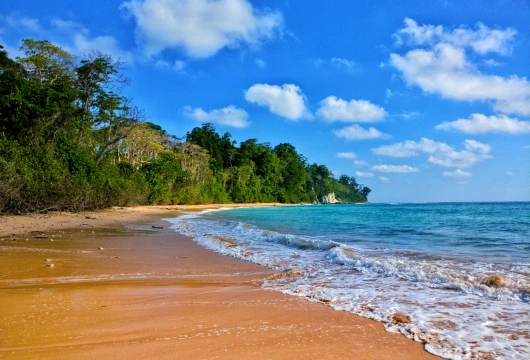Andaman and Lakshadweep Achieve Renewable Milestone
In a historic move, the Andaman, Nicobar Islands, and Lakshadweep are on track to become India’s first Union Territories to achieve 100% renewable energy generation. This initiative, driven by the Island Development Agency (IDA) and supported by the Ministry of New and Renewable Energy, highlights India’s commitment to sustainable development and green energy solutions.
During a recent meeting with Home Minister Amit Shah, the IDA confirmed the ambitious renewable energy project to transition these picturesque islands entirely to solar and wind energy. Established in 2017, the IDA focuses on developing India’s maritime economy while protecting its fragile ecosystems, and this renewable energy project is a testament to its objectives.
Harnessing the Power of Nature
Both the Andaman and Nicobar Islands and Lakshadweep are ideally positioned to exploit renewable energy sources. Their locations provide abundant sunlight and consistent wind flows, making them perfect candidates for solar panels and windmills.
The Indian government, through its Press Information Bureau, has announced that solar panels will be installed in every household across the islands. This initiative aims to meet energy demands sustainably and empower residents with reliable and eco-friendly electricity.
Home Minister Shah emphasized the importance of these initiatives in aligning with India’s broader renewable energy goals, stating:
“Achieving 100% renewable energy in Andaman, Nicobar, and Lakshadweep sets a benchmark for sustainable practices in remote regions and reinforces our commitment to a greener future.”
A Step Toward India’s Green Energy Future
India’s renewable energy landscape has seen remarkable progress in recent years. However, successfully implementing 100% renewable energy systems in Andaman, Nicobar, and Lakshadweep is a pioneering effort.
Unlike mainland states, which face infrastructural and logistical challenges in scaling up renewable energy, these islands offer unique opportunities due to their smaller populations and isolated geography. By fully transitioning to renewables, the islands will reduce their reliance on diesel-powered electricity, cut carbon emissions significantly, and set a precedent for other regions.
This initiative also supports India’s commitment to the Paris Agreement and its ambitious renewable energy targets. While other Union Territories and states are still navigating the complexities of renewable integration, the Andaman, Nicobar Islands, and Lakshadweep are setting an inspiring example.
Governance and Renewable Energy Leadership
India’s administrative framework, which includes 28 States and 8 Union Territories, provides varied governance structures. Union Territories like Andaman, Nicobar, and Lakshadweep are governed directly by the central government, allowing for streamlined implementation of large-scale projects like this renewable energy transition.
The Island Development Agency plays a crucial role in this transformation. Since its inception, the IDA has focused on preserving the unique ecosystems of these remote islands while ensuring economic growth. This renewable energy project aligns seamlessly with these goals, balancing development with environmental conservation.
Challenges and Triumphs
Transitioning an entire region to renewable energy comes with challenges, including logistical complexities, the high initial cost of infrastructure, and the need for skilled labor to install and maintain the systems. However, the benefits far outweigh the hurdles.
The use of solar panels and windmills will drastically reduce the island’s dependence on imported diesel, which is both costly and environmentally detrimental. Furthermore, the availability of clean and consistent energy will improve the quality of life for residents, foster economic growth, and boost eco-tourism—a key industry for these regions.
The success of this project also paves the way for similar initiatives in other parts of India, particularly in remote or off-grid areas where renewable energy can be a game-changer.
Inspiring Broader Change
The renewable energy achievement in Andaman and Lakshadweep is more than just a milestone for the islands; it is a beacon of hope for a sustainable future. By showcasing the feasibility of transitioning to 100% renewable energy, these Union Territories are setting a model for others to emulate.
This initiative highlights the transformative potential of renewable energy for policymakers, entrepreneurs, and environmentalists. It demonstrates that even the most remote regions can lead the way in sustainable practices with the right combination of vision, resources, and determination.
A Vision for Tomorrow
The move to 100% renewable energy in Andaman, Nicobar Islands, and Lakshadweep is a significant step toward India’s larger environmental and energy goals. It underscores the country’s commitment to creating a sustainable, carbon-neutral future while ensuring that economic
development does not come at the cost of environmental degradation.
As these islands become powered entirely by renewable energy, they will preserve their pristine ecosystems and inspire other regions worldwide to take bold steps in addressing climate change.
Join the Renewable Energy Movement
This milestone is a call to action for individuals, organizations, and governments worldwide. We can collectively shape a greener, healthier planet by supporting renewable energy initiatives, advocating for sustainable practices, and investing in clean energy technologies.
Let the stories of Andaman, Nicobar, and Lakshadweep remind us of what is possible when we prioritize renewable energy and sustainable development. Together, we can ensure a brighter future for generations to come.
For more in-depth analysis and inspiring climate news, click here.

